Scale insects and mealybugs are ubiquitous in managed landscapes. Although they are most commonly managed in the landscape on ornamental plants, this group of insects can also be damaging pests of warm season turfgrasses. To date, little research has investigated management strategies for these pests in turfgrasses, and few products are labeled or tested for their control. This document is intended to provide an overview of the identification, biology, ecology, and management of the most common scale insect and mealybug pests found in warm season turfgrasses in the southern United States.
At least four species of leaf-feeding scale insects and mealybugs are pests of turfgrasses in the southeastern United States and Florida: Rhodesgrass mealybug (Antonina graminis (Maskell): Pseudococcidae), Tuttle mealybug (Brevennia rehi (Lindinger): Pseudococcidae), bermudagrass scale (Odonaspis ruthae (Kotinsky): Diaspididae), and Duplachionaspis divergens (Green) (Diaspididae). A fifth group of turfgrass scale insect pests, ground pearls (Dimargarodes meridionalis (Morrison): Margarodidae), live in the soil and feed on turfgrass roots. Most of these insects are occasional pests, but all can be difficult to control and may cause extensive damage if left unmanaged.
Scale Insect and Mealybug Biology
Scale insects and mealybugs are piercing-sucking pests (Hemiptera, superfamily Coccoidea) that feed on plant sap from the vascular tissue or plant cells within plant leaves, stems, and roots. These insects go through incomplete metamorphosis, which means immatures and adults feed on the same plant material, physically resemble each other, and cause similar damage. Mealybugs (Pseudococcidae) and soft scale insects (Coccidae) excrete honeydew as waste, whereas armored scale insects (Diaspididae) do not. Therefore, mealybugs and soft scales are often associated with sooty mold while armored scales are not. Scale insects and mealybugs are difficult to find and control because they are small, typically infest well-hidden locations or hard-to-reach areas of plants, and live a sedentary lifestyle. In addition, most species secrete a waxy material that covers their body at some point during their life and protects them from environmental conditions and control measures.
Scale Insect and Mealybug Damage
Landscape managers are generally more familiar with mealybug and scale insect damage to ornamental plants than turfgrass. However, damage caused by these pests in turfgrass is similar. Mealybugs and soft scale insects feed on plant sap, which contains high amounts of sugars that the grass needs for growth. The insects ingest large amounts of sap, but do not metabolize much of its content. Thus, plant material turns yellow or brown and dies back while the insects excrete large amounts of sugary waste, called honeydew. This honeydew makes the turf sticky and provides a resource for black sooty mold fungus to grow, which can further exacerbate plant damage. Heavily infested areas of turfgrass appear generally unhealthy, resembling drought stress or disease.
Rhodesgrass Mealybug, Antonina graminis
Identification
Rhodesgrass mealybugs have a distinct appearance that sets them apart from most other turf-infesting insect pests. They have round, dark brown bodies that are typically covered with a white, waxy secretion. This waxy covering resembles a tuft of cotton on the grass stem (Figure 1). This mealybug feeds under the leaf sheath, on leaf nodes, or within the crown of the plant. Mature females are most noticeable because they produce a spindly waxy fiber that extends from their round cottony body (Figure 2).
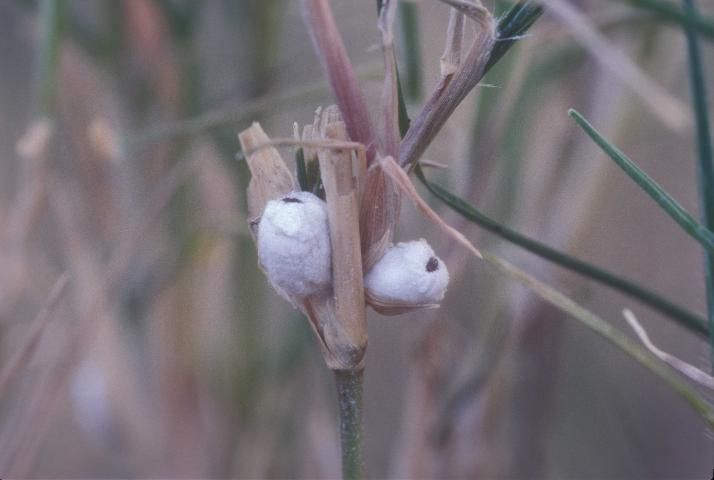
Credit: Lyle Buss, UF/IFAS
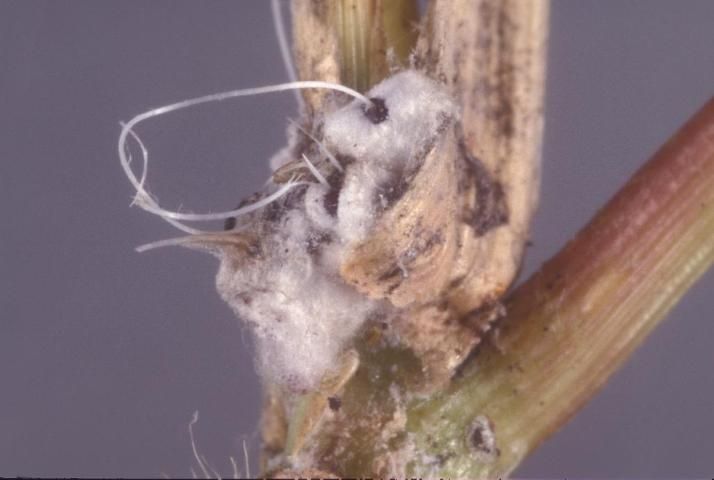
Credit: Lyle Buss, UF/IFAS
Biology
Females reproduce parthenogenetically (without mating) and deposit 300–600 eggs in a cottony ovisac. There are no males. The nymphs (called crawlers) disperse and begin feeding under a leaf sheath at a node. A white, spherical, waxy sac is secreted around them. After finding a feeding site, the insects will settle in and not move again. The life cycle of Rhodesgrass mealybug ranges from 60–70 days. In northern Florida, there are five generations per year, while generations are continuous and overlapping in southern Florida.
There are at least 14 natural enemies of rhodesgrass mealybug, including predatory beetles and parasitoid flies and wasps from nine genera within five families. Some ants, including the red imported fire ant (RIFA), may be found associated with these insects. The ants feed on honeydew excretions and protect the mealybugs from natural enemies.
Distribution
Rhodesgrass mealybug is distributed worldwide in tropical and subtropical climates. In the United States, it is primarily found the Gulf Coast region. This insect is widely distributed throughout Florida.
Host Plants
The Rhodesgrass mealybug has a wide range of host plants including 63 genera in four families. Most hosts are grasses (Poaceae) and it prefers rhodesgrass (Chlors gayana Kunth), johnsongrass (Sorghum halepense), bermudagrass (Cynodon dactylon), and St. Augustinegrass (Stenotephrum secundatum) in Florida.
Damage
As with other mealybugs and soft scale insects, the Rhodesgrass mealybug feeds on plant sap and secretes honeydew as waste, which makes plant surfaces sticky and facilitates the growth of black sooty mold. Infested grass gradually yellows and shows symptoms resembling drought stress. Damage is most severe during extended hot, dry periods.
Tuttle Mealybug, Brevennia rehi
The Tuttle mealybug is globally distributed. It is also known as the rice mealybug because it is a damaging pest of rice and sugarcane in Asia where those are its primary hosts. This pest was first documented in Florida in 1975 in Pompano Beach, but was rarely found or associated with turfgrass damage until the early 2000s. In recent years, perhaps coupled with the increasing popularity of zoysiagrass lawns, these insect pests have become more commonly found damaging turfgrass.
Identification
Tuttle mealybug is small (<1/10 inch or <2 mm) and difficult to find in low numbers. In addition, it feeds in concealed locations, commonly beneath the leaf sheath or between grass blades and the stem. These insects have pink, oval-shaped bodies and secrete a white, waxy substance that covers their body and parts of leaves (Figure 3). Adult females are larger and often covered with more wax than nymphs. The white wax is often the best indicator of infestation. Although not common, the Winnemuca grass mealybug and pink sugarcane mealybug have been found on turfgrass and resemble Tuttle mealybug in appearance. Therefore, mealybugs must be collected and sent to Florida Department of Agriculture and Consumer Services—Division of Plant Industry (FDACS-DPI) for proper identification. However, management is likely the same.
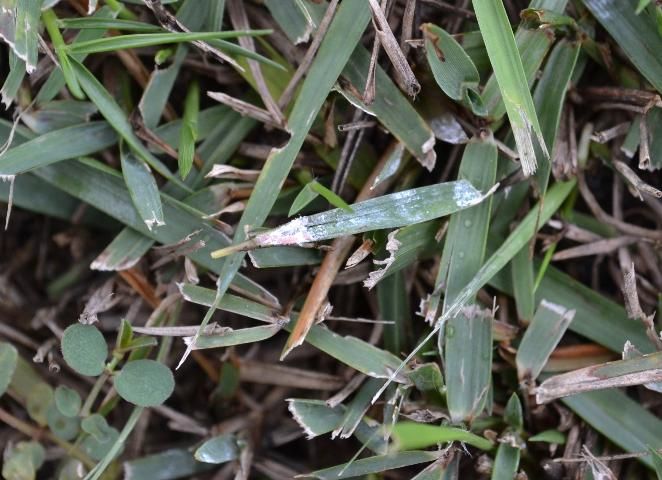
Credit: Adam Dale, UF/IFAS
When surveying for these insects, one must closely inspect the plant material in and adjacent to several areas exhibiting damage. A 10–40X hand lens or field microscope will be helpful. Insects will be found concealed in the leaf sheath and near the base of the plants, so close examination is critical. Look for the white, waxy substance as well as the presence of black sooty mold.
Biology
Little is known about the biology of this insect. Like other mealybugs, Tuttle mealybug goes through incomplete metamorphosis and feeds on plant sap with piercing-sucking mouthparts. Nymphs (Figure 4) and adults are often found cohabiting the same space on plant material. There are two parasitoid wasps (Encyrtidae) that attack Tuttle mealybug but they have not been documented in Florida. Little is known about what else attacks them, but generalist predators like beetles, spiders, and predatory bugs are likely providing some level of control.

Credit: Adam Dale, UF/IFAS
Distribution
These insects were first documented in the United States in Arizona in 1950. In Florida, Tuttle mealybug has been found primarily in southern counties (Miami-Dade, Lee, Collier, and Palm Beach Counties), with a report as far north as Orange County in 2012. Recent collections from northeastern (Duval County) and northwestern (Walton County) Florida in 2016 confirm that these pests are more widely distributed and damaging in Florida.
Host Plants
Tuttle mealybug primarily feeds on plants in the grass family (Poaceae). It is most often found feeding on and damaging zoysiagrass lawns, although it is also a pest of bermudagrass. It has been found on signal grass, crowfoot grass, goose grass, and several ornamental grasses.
Damage
Heavily infested areas of turfgrass appear generally unhealthy, resembling drought stress or disease (Figure 5). Damage can be widespread in lawns and become severe rather quickly due to the insect's non-descript nature and the insect's obscure behavior.
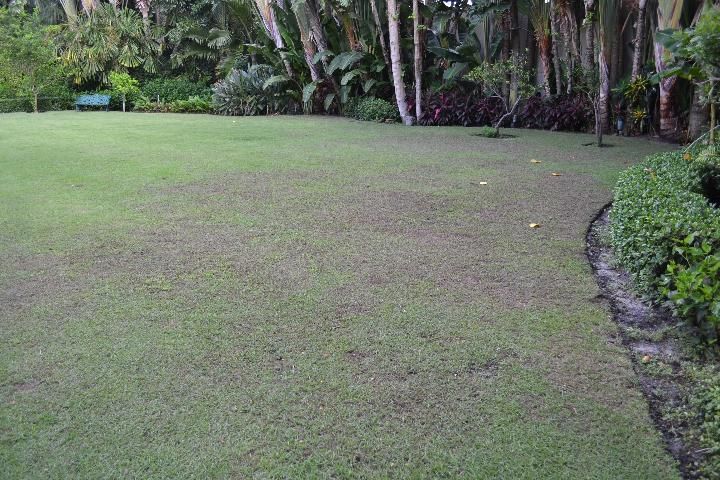
Credit: Adam Dale, UF/IFAS
For more information on Tuttle mealybug, see https://edis.ifas.ufl.edu/in989.
Bermudagrass Scale, Odonaspis ruthae
Bermudagrass scale is an armored scale insect that is found primarily on bermudagrass. This scale insect is more commonly found in taller growing areas and has been associated with heavy shade. Bermudagrass scale is more commonly found in golf course roughs, around sand traps, or along fencerows.
Identification
Individuals will be found tight against grass stems, often concealed within the leaf sheath, and are more commonly located near the base of the plant. The Bermudagrass scale adult female is oval, white, and approximately 1/20 inch (1–1.75 mm) in diameter, resembling a fried egg (Figure 6). Nymphs, called crawlers, are cream or brown in color and the only mobile life stage that can establish populations. Nymphs have been observed crawling across the surface of bermudagrass in areas showing damage.

Credit: Adam Dale, UF/IFAS
Biology
The life cycle of a Bermudagrass scale ranges from 60–70 days, with five generations per year in northern Florida and continuous generations in southern Florida. There are two natural enemies of this insect, a parasitic wasp (Adelencyrtus odonaspidis Fullaway; Encyrtidae) and a predatory thrips (Podothrips semiflavus Hood; Phlaeothripidae). The parasitoid wasp is documented in Florida and Hawaii.
Distribution
This insect is distributed worldwide and throughout Florida. It was first reported as a damaging pest of forage and turfgrasses in the southern United States in 1964.
Host Plants
Bermudagrass scale is reported to feed on multiple hosts from 29 genera in six families. By far the most common hosts are grasses (Poaceae). It is reported as a major pest of bermudagrass grown in high-maintenance landscapes such as golf courses.
Damage
As with other armored scale species, this pest extracts sap by piercing individual plant cells. Feeding from dense populations results in gradual plant yellowing (chlorosis) and browning (tissue necrosis), and may lead to leaf, leaf-blade, or entire plant death. Stands of turfgrass decline slowly and resemble drought-stressed turf. Because this is an armored scale insect, bermudagrass scale will not produce sticky honey dew or be associated with sooty mold.
Duplachionaspis divergens
A more recently introduced armored scale insect pest, Duplachionaspis divergens, has become established in Florida. The potential economic impact of this pest is unknown, but it has been detected on several species of grasses. Infested grass clippings should be collected and destroyed to prevent further spread.
Identification
Duplachionaspis divergens is similar in appearance to the common ornamental plant pest false oleander scale (Pseudaulacaspsis cockerelli Cooley). Female D. divergens are oyster shell-shaped, white in color, and approximately 1/10 inch (3 mm) long. Males are much smaller (1/25 inch long or 1 mm) and uniform along the length of their body. Individuals are typically found along the leaves of grasses (Figure 7).
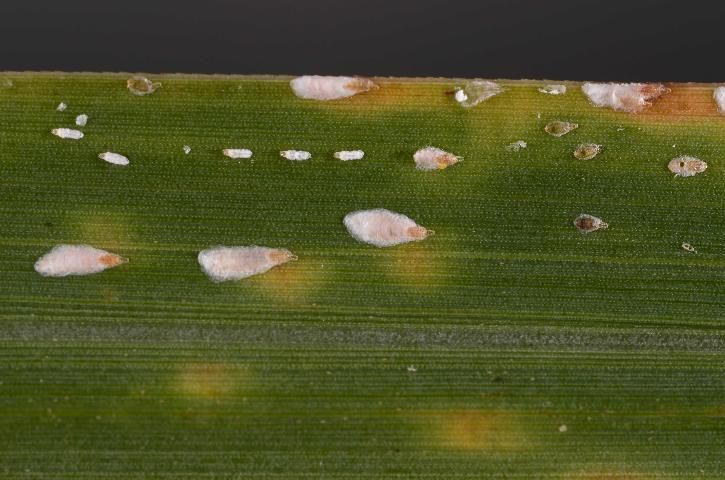
Credit: Lyle Buss, UF/IFAS
Biology
This pest is reported to have nine generations per year in warmer climates, taking approximately 39 days to complete a generation. An average adult female produces 130 eggs in her lifetime. These insects are attacked by parasitoid wasps from five genera in the families Aphelinidae and Encyrtidae.
Distribution
This scale insect is documented throughout much of the eastern hemisphere. It was first documented in the United States in 2000 in Manatee County, Florida. This insect is now distributed throughout much of south Florida and parts of north Florida. Since its first documentation in Florida, D. divergens has been found in other gulf coast states including Alabama and Texas.
Host Plants
Duplachionaspis divergens has been detected on multiple host plants from 14 genera of grasses (Poaceae). These include Miscanthus spp., St. Augustinegrass, bahiagrass (Paspalum notatum), zoysiagrass (Zoysia spp.) (Figure 8), and other Paspalum spp.
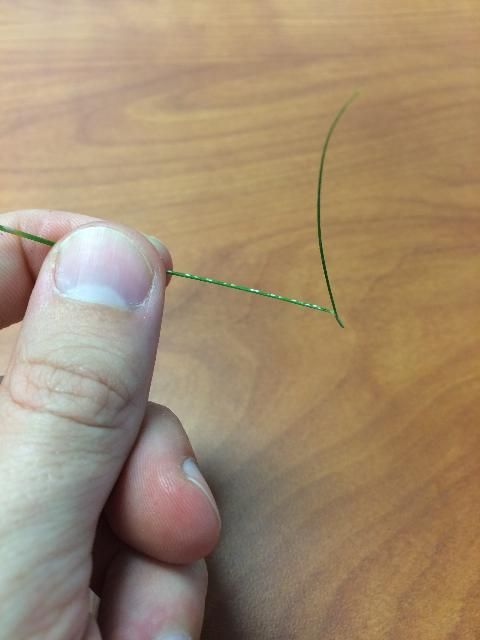
Credit: Adam Dale, UF/IFAS
Damage
Although this pest is occasionally found in high numbers, D. divergens is considered a minor pest of grasses. Grass blades turn yellow and brown at sites where insects are feeding.
Ground Pearls, Dimargarodes meridionalis
Identification
Ground pearls are found in the soil up to 10 inches (25 cm) below the surface. Eggs are pink to white and covered in a white waxy case. Nymphs form yellow to brown spherical shells or cysts, which is the basis of the name "pearl." These cysts (Figure 9) range in size from about 1/50–1/20 inch (0.5–1.5 mm). The adult female is wingless, 1/20 inch (1.5 mm) long, pink in color, and has well-developed forelegs and claws (Figure 10). Adult males are not commonly seen, but have wings and are gnat-like.

Credit: Lyle Buss, UF/IFAS
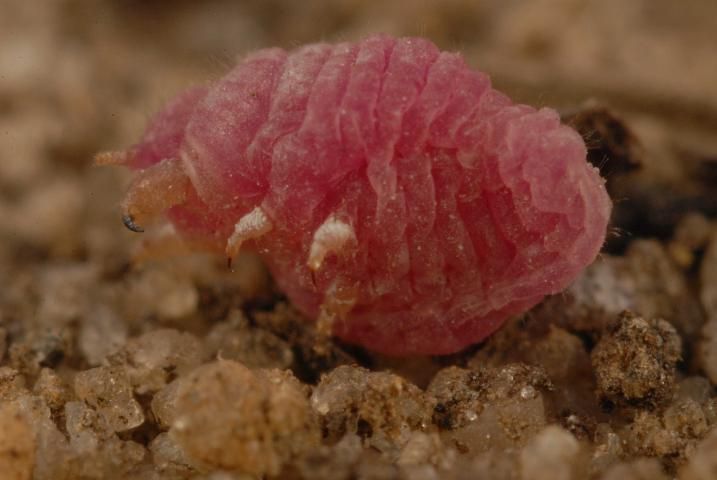
Credit: Lyle Buss, UF/IFAS
Biology
Clusters of pinkish-white eggs, covered in a white waxy sac, are deposited in the soil from March to June. The first-stage nymphs (called crawlers) emerge from eggs approximately 9–15 days later, attach to the roots, and enclose themselves in a hard, yellow-brown, globular shell. Ground pearls overwinter in the cyst stage and females reach maturity in late spring. Females can reproduce without mating. One generation may last from one to two years. There are no known natural enemies of ground pearls in turfgrass.
Distribution
Ground pearl pests of grasses are distributed throughout the southern United States, parts of the tropical Americas, and regions of South America. In the United States, D. meridionalis has been found in Florida, Georgia, Alabama, South Carolina, North Carolina, Arizona, and California. In Florida, they are most common and damaging in the panhandle where there is a higher concentration of centipedegrass used for lawns.
Host Plants
Ground pearls feed on the roots of bermudagrass, St. Augustinegrass, and zoysiagrass, but prefer centipedegrass (Eremochloa ophiuroides Munro), hence the species common name.
Damage
Ground pearl feeding causes irregular patches of yellow, brown, or dying grass. Damage is most commonly noticed during spring green-up, especially during hot, dry weather. Grass rarely recovers and weeds often invade the damaged areas.
Management
There are currently no management strategies, including insecticides, available for ground pearls. Use best management practices (BMP) to minimize plant stress, and maintain proper fertility and soil moisture to help grass tolerate the damage.
For more information on ground pearls, see https://edis.ifas.ufl.edu/in554.
Scale Insect and Mealybug Management
Little research has been conducted to determine the best strategies for managing scale insects and mealybugs in turfgrass. In general, management is challenging because the insects are difficult to reach with insecticides, the waxy secretions protect the body from contact by insecticides, and they are difficult to detect before they become highly abundant. When populations reach high levels, they can be extremely difficult to control and often take weeks to months to reduce below damaging levels.
Mechanical Control
Some insect pests can be effectively managed by physically removing them from the landscape. Although most scale insects and mealybugs are found primarily near the base of the plant, collecting and discarding of grass clippings when mowing a lawn with a heavy infestation may help reduce the population.
Cultural Control
Maintaining a dense, healthy stand of turfgrass while minimizing inputs and disturbances is the best defense against scale insect and mealybug outbreaks. Follow UF/IFAS-recommended irrigation, fertilization, and mowing practices. Over-fertilization, drought stress, improper mowing, and thatch buildup may all contribute to increased insect abundance.
Biological Control
Most scale insects and mealybugs are attacked by a suite of parasitoid wasps (Figure 11) and predatory insects. In fact, these pests are typically kept below damaging levels in their native, natural habitats. However, when insects are outside of their native habitat or are in intensively managed landscapes, this ecosystem balance no longer exists.
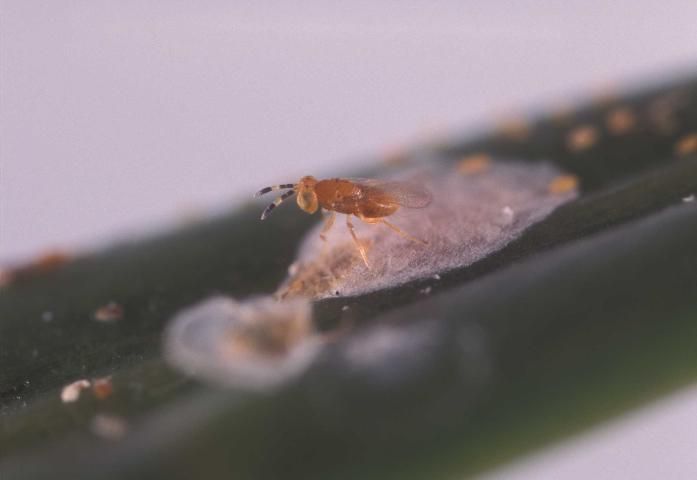
Credit: Lyle Buss, UF/IFAS
Chemical Control
Scale insects and mealybugs are most effectively controlled with thorough coverage of systemic insecticides. Contact-toxic products often perform poorly because they must come into physical contact to work, and sufficient and uniform coverage can be difficult to achieve. In contrast, systemically active products are ingested during regular feeding. In addition, most systemic products are compatible with natural enemies, which allows biological control to occur in between product applications. Since armored scale insects like bermudagrass scale feed from individual plant cells instead of the vascular system, control is more difficult and works more slowly. Scale insects and mealybugs are most easily killed when they are nymphs (crawlers) due to their small size and lack of wax. Therefore, monitor infestations and time applications accordingly when possible.
There are few insecticide options available to control scale insects and mealybugs in turfgrass. In addition, little research has been conducted to determine their efficacy against these pests. Systemic products like neonicotinoids are preferred because they have longer residual activity inside plant tissue. Broad-spectrum products such as pyrethroids and carbamates (Sevin) may initially reduce pests but are not active systemically, will not provide lasting control, and will also kill natural enemies. Several combination products that contain pyrethroids and neonicotinoids (e.g. bifenthrin + imidacloprid) may provide initial high knock-down rates followed by longer systemic control. However, more work is needed to determine the long-term effects. Always follow label directions and restrictions when applying these products and rotate modes of action to reduce the risk of insecticide resistance.
Secondary Pest Outbreaks
Cover-spray applications of broad-spectrum insecticides often lead to secondary pest outbreaks. Secondary pests are those that exist in the landscape below damaging levels but increase rapidly following the application of broad-spectrum, non-selective, insecticides that were applied targeting another pest. These products (e.g. pyrethroids, carbamates) are toxic to all arthropods in the treatment area, both pests and natural enemies.
Scale insects and mealybugs are secondary pests that may increase following such disturbances to the ecosystem balances in a landscape. For this reason, we often see more scale insect and mealybug outbreaks in landscapes that have been exposed to intensive broad-spectrum insecticide applications. Therefore, be aware of the selectivity of the products being used and the area to which they are applied. Always use selective products when possible, and spot-treat infestations to reduce toxicity to biological control organisms inhabiting the landscape.
References
Abd-Rabou, S. 2001. Parasitoids attack mealybugs (Homoptera: Coccoidea: Pseudococcidae) in Egypt. Egyptian Journal of Agricultural Research 79(4): 1355–1376.
Ben-Dov, Y. 1988. A taxonomic analysis of the armored scale tribe Odonaspidini of the world (Homoptera: Coccoidea: Diaspididae). United States Department of Agriculture Technical Bulletin No. 1723, 142 pp.
Evans, G. A., and G. S. Hodges. 2007. Duplachionaspis divergens (Hemiptera: Diaspididae), a new exotic pest of sugarcane and other grasses in Florida. Florida Entomologist 90(2): 392–393.
García Morales, M., B. D. Denno, D. R. Miller, G. L. Miller, Y. Ben-Dov, and N. B. Hardy. 2016a. ScaleNet: A literature-based model of scale insect biology and systematics. Database. doi: 10.1093/database/bav118. http://scalenet.info/catalogue/Antonina%20graminis/
García Morales, M., B. D. Denno, D. R. Miller, G. L. Miller, Y. Ben-Dov, and N. B. Hardy. 2016b. ScaleNet: A literature-based model of scale insect biology and systematics. Database. doi: 10.1093/database/bav118. http://scalenet.info/catalogue/Odonaspis%20ruthae/
García Morales, M., B. D. Denno, D. R. Miller, G. L. Miller, Y. Ben-Dov, and N. B. Hardy. 2016c. ScaleNet: A literature-based model of scale insect biology and systematics. Database. doi: 10.1093/database/bav118. http://scalenet.info/catalogue/Brevennia%20rehi/
García Morales, M., B. D. Denno, D. R. Miller, G. L. Miller, Y. Ben-Dov, and N. B. Hardy. 2016d. ScaleNet: A literature-based model of scale insect biology and systematics. Database. doi: 10.1093/database/bav118. http://scalenet.info/catalogue/Duplachionaspis%20divergens/
García Morales, M., B. D. Denno, D. R. Miller, G. L. Miller, Y. Ben-Dov, and N. B. Hardy. 2016e. ScaleNet: A literature-based model of scale insect biology and systematics. Database. doi: 10.1093/database/bav118. http://scalenet.info/catalogue/Dimargarodes%20meridionalis/
Gill, R. J. 1993. The Scale Insects of California: Part 2. The Minor Families (Homoptera: Coccoidea). California Department of Food and Agriculture. Sacramento, CA 241 pp.
Miller, D. R., and J. A. Davidson. 2005. Armored Scale Insect Pests of Tree and Shrubs. Cornell University Press. Ithaca, NY 442 pp.
Yu, H. M., and S. Su. 2012. A new record for the genus Duplachionaspis armored scale (Hemiptera: Diaspididae) from Korea. Korean Journal of Applied Entomology 52(1): 63–67.